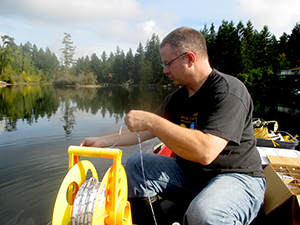
Shallow lake offers deep insight into lake chemistry
Nothing about Lake Killarney’s idyllic appearance hints at the potential cancer risk lying below the surface.
The shallow lake in South King County, Washington, is ringed with homes and the headquarters of the international relief organization World Vision. The lake is favored by waterfowl, rich with aquatic plants and stocked with rainbow trout, largemouth bass and other fish.
So it came as a surprise to Dr. James Gawel when he and his undergraduate students from the University of Washington (UW) Tacoma measured high levels of arsenic in water samples from Lake Killarney.
“It was pretty amazing to find this little lake that broke the rules about what we thought we knew about lake chemistry,” Gawel said.
Six times higher than level deemed harmful

The lake is located downwind from the former ASARCO smelter in Ruston. Aerial transport of lead and arsenic from the former smelter led to widespread contamination in the area and its eventual designation as one of the first Superfund sites in the nation.
“Normally, when oxygen is present, arsenic tends to stick to particles and fall out of the water column,” Gawel explained, and then settle at the bottom in the sediments.
Gawel is an associate professor in UW Tacoma’s School of Interdisciplinary Arts and Sciences. He studies arsenic in lakes as part of the UW Superfund Research Program housed at UW’s Department of Environmental & Occupational Health Sciences. The program—one of the first university-based Superfund research centers—conducts research on environmental chemicals and remediation practices for hazardous waste sites.
Lake Killarney turned out to have levels of arsenic more than six times the minimum level that the Washington Department of Ecology identifies as likely to have harmful effects on sediment-dwelling organisms.
Gawel recently co-authored a paper about arsenic in shallow lakes in Science of the Total Environment with Dr. Rebecca Neumann, assistant professor in the UW Department of Civil and Environmental Engineering.
How arsenic enters the food chain

Even given the area's environmental history and the high levels of arsenic in the sediment, finding it in Lake Killarney’s water column was a surprise.
Shallow lakes like Lake Killarney are less likely to show the type of stratification that larger lakes exhibit, Gawel explained. In summer, cold, heavier waters typically occupy lake bottoms in a layer that doesn’t mix with warmer surface waters because of their different densities. This stratification tends to keep arsenic trapped at the bottom of the lake.
In contrast, shallow lakes warm up more thoroughly and don’t form separate layers. That leaves more opportunity for arsenic in the sediment to mix into the water.
Second, arsenic resembles phosphorus in its chemical structure—enough so that microscopic marine algae can mistakenly take it up instead of the phosphorus they need to grow and reproduce.
In oxygen-rich water, these phytoplankton can take up arsenic so quickly that it doesn’t have a chance to bind to particles and settle into the sediment. Instead, arsenic enters the food chain as part of the phytoplankton that feed zooplankton, insects, fish and other organisms.
What’s the health risk?

Does arsenic in shallow lakes pose a hazard to human health?
Exposure to arsenic is known to increase the risks of cancer. But because arsenic is water-soluble, it can be flushed from the body rather than accumulating in fat, and it diminishes in concentration as it moves up the food chain.
One of the biggest concerns is the level of potential arsenic exposure associated with eating warm-water fish species like sunfish, crappies and bottom-dwelling crayfish. These fish are favored by people who visit Lake Killarney and other area lakes to fish for supplemental food for their families.
Gawel and Neumann are currently collaborating with Dr. Julian Olden of UW’s School of Aquatic and Fisheries Science to sample arsenic in lake fish and crayfish. Olden will begin gill-netting this summer at Lake Killarney and other area lakes.
Ultimately, Gawel said the team wants to better understand the chemical and physical transfer of arsenic from sediments to lake water and characterize how much arsenic may make its way into the fish people catch and eat.

